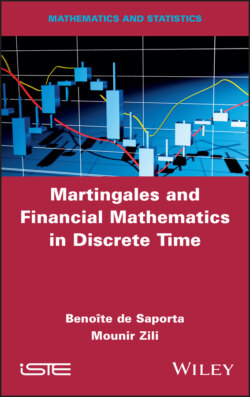Читать книгу Martingales and Financial Mathematics in Discrete Time - Benoîte de Saporta - Страница 17
1.4. Exercises
ОглавлениеEXERCISE 1.1.– Let Ω = {a, b, c}.
1 1) Completely describe all the σ-algebras of Ω.
2 2) State which are the sub-σ-algebras of which.
EXERCISE 1.2.– Let Ω = {a, b, c, d}. Among the following sets, which are σ-algebras?
1 1)
2 2)
3 3)
4 4)
For those which are not σ-algebras, completely describe the σ-algebras they generate.
EXERCISE 1.3.– Let X be a random variable on (Ω, ) and let be a sub-σ-algebra of . Show that X is -measurable if and only if σ(X) ⊂ .
EXERCISE 1.4.– Let A ∈ and let be a sub-σ-algebra of . Show that is -measurable if and only if A ∈ .
EXERCISE 1.5.– Let Ω = {P, F} × {P, F} and = = (Ω), corresponding to two successive coin tosses. Let
– X1 be the random variable number of T on the first toss;
– X2 be the number of T on the second toss;
– Y be the number of T obtained on the two tosses;
– and Z = 1 if the two tosses yielded an identical result; otherwise, it is 0.
1 1) Describe 1 = σ(X1) and 2 = σ(X2). Is X1 2-measurable?
2 2) Describe = σ(Y). Is Y 1-measurable? Is X1 -measurable?
3 3) Describe = σ(Z). Is Z 1-measurable, -measurable? Is X1 -measurable?
4 4) Give the inclusions between , 1, 2, and .
EXERCISE 1.6.– Let (Xn)n≥1 be a sequence of independent random variables with the same Rademacher distribution with parameter 1/2:
Let S0 = 0 and The process S = (Sn)n∈ℕ is called the simple symmetric random walk on . It will be studied in detail in Chapter 3. We write X0 = 0. Show that the filtration generated by the sequence (Xn)n∈ℕ is the same as that generated by the sequence (Sn)n∈ℕ.
EXERCISE 1.7.– Consider the following game of chance. A player begins by choosing a number between 6 and 8 (inclusive), which we call the principal. The player then rolls 2 uncut, six-sided, non-rigged dice and sums the result. The wins are as follows:
– If the sum is 2 or 3, the player loses 1 DT (Tunisian dinar).
– If the sum is 11, the player wins 1 DT if the principal is 7; otherwise, they lose 1 DT.
– If the sum is 12, the player wins 1 DT if the principal is 6 or 8; otherwise, they lose 1 DT.
– Finally, in all other cases, nothing happens (no win, no loss).
1 1) Determine Ω, the universe of all outcomes of the experiment.
2 2) S is the random variable giving the sum of the two dice. Determine the distribution of S.
3 3) X7 is the random variable giving the player’s winnings (negative in the case of a loss) when the principal is 7. Determine the distribution of X7.
4 4) Calculate [X7] and (X7).
5 5) We consider X6 to be the winnings of the player when the principal is 6. Determine the distribution of X6 and then calculate [X6].
EXERCISE 1.8.– Let p ∈]0, 1[. We have one coin that leads to tails with the probability p. We toss this coin until we obtain tails for the second time. Let X be the number of heads obtained during this experiment.
1 1) Determine the distribution of X.
2 2) Justify the existence of the expectation of X.
3 3) Calculate [X].
